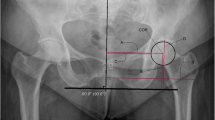Abstract
Purpose
A source of radiological bias occurs when the axial rotation of the pelvis is disregarded in hip and spine biomechanics analyses. The EOS imaging system (EOS Imaging, France) offers the possibility of detecting and measuring the axial rotation of bones. Reproducibility and accuracy have not been documented in the case of the pelvis.
Methods
A dry pelvis has been X-rayed with the EOS system every 5° from 30° left to 30° right according to a laser line reference goniometer. Three observers have measured the rotation. One observer did it 3 times. The intra- and inter-observer reproducibility and the accuracy have been calculated using the root mean square standard deviation calculation. The relationship between the axial rotation and the offset between the left and right acetabulae on the lateral view was investigated.
Results
The 95 % CI was ±0.23° for the intra-observer and ±0.33° for the inter-observer reliability. The mean of signed differences between the software calculation and the actual axial rotation of the pelvis was −0.39° (SD 0.77°). The lateral acetabular offset was proportional to the sin of the rotation. Approximately, 30 mm offset corresponded to about 10° rotation.
Conclusions
The 3D slot scanning imaging system demonstrated significant reproducibility and accuracy for the assessment of the axial rotation of the pelvis.



Similar content being viewed by others
References
Dubousset J, Charpak G, Dorion I, Skalli W, Lavaste F, Deguise J, Kalifa G, Ferey S (2005) A new 2D and 3D imaging approach to musculoskeletal physiology and pathology with low-dose radiation and the standing position: the EOS system. Bull Acad Natl Med 189:287–297 discussion 297-300
Rousseau MA, Laporte S, Chavary-Bernier E, Lazennec JY, Skalli W (2007) Reproducibility of measuring the shape and three-dimensional position of cervical vertebrae in upright position using the EOS stereoradiography system. Spine (Phila Pa 1976) 32:2569–2572
Rousseau MA, Laporte S, Dufour T, Steib JP, Lazennec JY, Skalli W (2011) Three-dimensional assessment of the intervertebral kinematics after Mobi-C total disc replacement at the cervical spine in vivo using the EOS stereoradiography system. SAS J 5:63–68
Pomero V, Mitton D, Laporte S, de Guise JA, Skalli W (2004) Fast accurate stereoradiographic 3D-reconstruction of the spine using a combined geometric and statistic model. Clin Biomech (Bristol Avon) 19:240–247
Glaser DA, Doan J, Newton PO (2012) Comparison of 3-dimensional spinal reconstruction accuracy: biplanar radiographs with EOS versus computed tomography. Spine (Phila Pa 1976) 37:1391–1397
Lazennec JY, Rangel A, Baudoin A, Skalli W, Catonne Y, Rousseau MA (2011) The EOS imaging system for understanding a patellofemoral disorder following THR. Orthop Traumatol Surg Res 97:98–101
Lazennec JY, Boyer P, Gorin M, Catonne Y, Rousseau MA (2011) Acetabular anteversion with CT in supine, simulated standing, and sitting positions in a THA patient population. Clin Orthop Relat Res 469:1103–1109
Vialle R, Levassor N, Rillardon L, Templier A, Skalli W, Guigui P (2005) Radiographic analysis of the sagittal alignment and balance of the spine in asymptomatic subjects. J Bone Joint Surg Am 87:260–267
Lazennec JY, Rousseau MA, Rangel A, Gorin M, Belicourt C, Brusson A, Catonne Y (2011) Pelvis and total hip arthroplasty acetabular component orientations in sitting and standing positions: measurements reproducibility with EOS imaging system versus conventional radiographies. Orthop Traumatol Surg Res 97:373–380
Lazennec JY, Brusson A, Rousseau MA (2011) Hip-spine relations and sagittal balance clinical consequences. Eur Spine J 20(Suppl 5):686–698
Acknowledgments
Thanks to Christophe Gomes from EOS Imaging for his personal involvement in this study.
Conflict of interest
The authors declare that they have no conflict of interest.
Author information
Authors and Affiliations
Corresponding author
Rights and permissions
About this article
Cite this article
Rousseau, MA., Brusson, A. & Lazennec, JY. Assessment of the axial rotation of the pelvis with the EOS® imaging system: intra- and inter-observer reproducibility and accuracy study. Eur J Orthop Surg Traumatol 24, 891–895 (2014). https://doi.org/10.1007/s00590-013-1281-3
Received:
Accepted:
Published:
Issue Date:
DOI: https://doi.org/10.1007/s00590-013-1281-3




